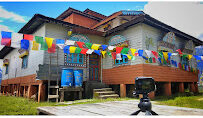Mechuka Monastery
Spiritual Gem of Arunachal Pradesh
An ancient Buddhist gompa surrounded by mountains, culture, and breathtaking landscapes.
Explore NowIntroduction
Nestled in the enchanting Mechuka Valley of Arunachal Pradesh, the Mechuka Monastery is a spiritual sanctuary and one of the region’s oldest Buddhist monasteries. Known locally as Samten Yongcha Monastery, it belongs to the Mahayana sect of Buddhism and is said to be over 400 years old.
Perched on a gentle hilltop with sweeping views of snow-capped mountains, gurgling rivers, and quaint villages, the monastery is both a sacred pilgrimage site and a scenic retreat for travelers. Visiting Mechuka Monastery is a chance to embrace faith, serenity, and authentic Northeast India culture all in one journey.
Highlights of Mechuka Monastery
- ✓Ancient Buddhist monastery with over 400 years of history.
- ✓Situated in the stunning Mechuka Valley near the Indo-Tibet border.
- ✓Rich in Tibetan Buddhist culture, rituals, and architecture.
- ✓Surrounded by snow-capped mountains, rivers, and lush meadows.
- ✓A must-visit for pilgrims, trekkers, and culture enthusiasts.
- ✓Offers breathtaking sunrise and sunset views.

History & Spiritual Significance
The Mechuka Monastery, believed to be established in the 17th century, reflects the deep Buddhist traditions of the region. It is dedicated to Guru Padmasambhava, the revered saint who spread Buddhism across the Himalayas.
The monastery houses ancient Buddhist scriptures, sacred relics, and thangkas (religious paintings) that hold immense spiritual value. Monks here follow centuries-old rituals, and the monastery often becomes a vibrant hub during Buddhist festivals, when chants and prayers echo through the valley. For pilgrims, it is a site of devotion; for travelers, it is a window into the timeless spiritual heritage of Arunachal Pradesh.
Scenic Surroundings of Mechuka Valley
Beyond its religious value, the setting of the Mechuka Monastery is a spectacle in itself. The Siyom River flows gracefully through the valley, bordered by pine forests, rolling meadows, and snow-draped peaks.
Travelers are often captivated by the peaceful atmosphere, where silence is broken only by fluttering prayer flags and the sound of the river. The location also offers excellent opportunities for photography, meditation, and quiet reflection, making it an ideal retreat for those seeking both spirituality and nature’s embrace.
Local Culture & Experiences
A visit to Mechuka Monastery is incomplete without experiencing the unique culture of the Memba, Adi, and Tagin tribes who inhabit the valley. These communities practice a fascinating blend of Buddhism, shamanistic traditions, and folk rituals.
Travelers can enjoy homestays with warm local families, savor authentic dishes like thukpa, momos, and butter tea, and witness traditional dance performances during festivals. The monastery also serves as a center for learning, where monks and locals engage in preserving the valley’s Tibetan Buddhist heritage.
FAQs about Mechuka Monastery
It is located in Mechuka Valley, Shi-Yomi District, Arunachal Pradesh, near the Indo-Tibet border.
The monastery is over 400 years old and is one of the region’s oldest Buddhist sites.
The best time is between October and April, when the skies are clear, and the valley is at its scenic best.
Visitors can explore tribal culture, homestays, trekking trails, riversides, and scenic mountain views in Mechuka Valley.
Yes, tourists are welcome to explore the monastery, interact with monks, and participate in prayer sessions.
Yes, visitors can stay in local homestays, guesthouses, and small lodges within Mechuka town.
Closing Call-to-Action
The Mechuka Monastery is more than just a spiritual site – it is the heart of the mystical Mechuka Valley, where faith, nature, and culture converge. Whether you seek the blessings of Guru Padmasambhava, the calm of prayer flags fluttering in the breeze, or the thrill of exploring one of Arunachal’s most scenic valleys, this destination has it all.
At Welcome Arunachal, we invite you to discover the magic of Mechuka Monastery and embrace the authentic charm of Northeast India’s spiritual and cultural heritage.
Plan Your Journey